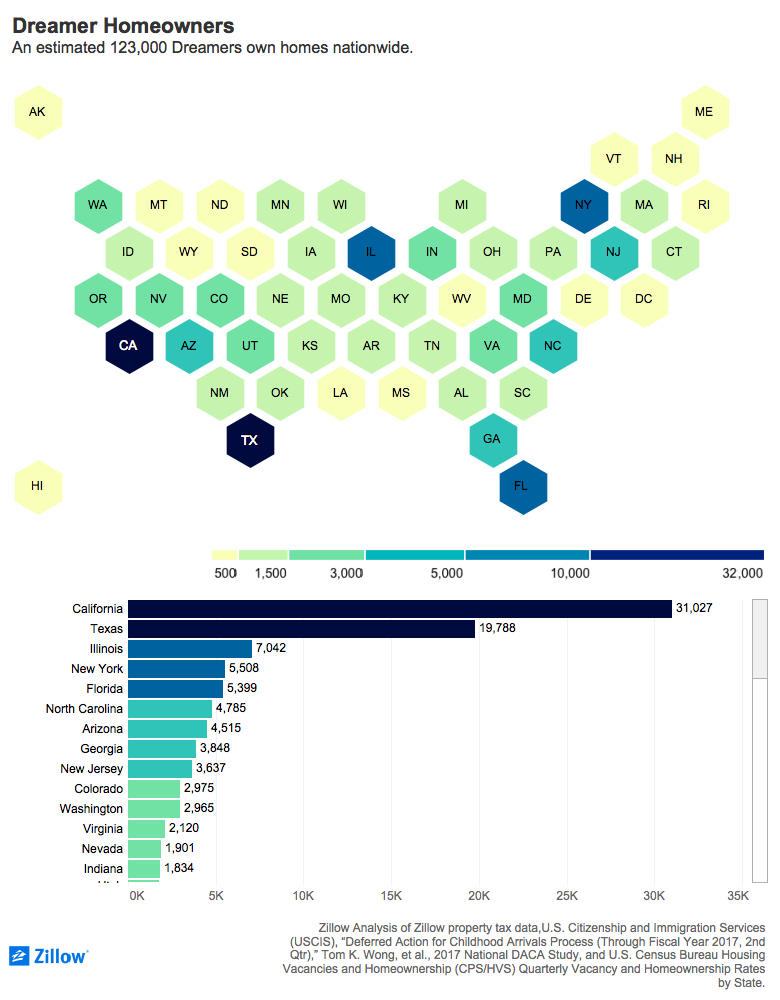An Estimated 123,000 ‘Dreamers’ Own Homes and Pay $380M in Property Taxes
California and Texas Dreamer homeowners pay enough in property taxes to fund the salaries of more than 1,500 elementary school teachers in each state for a year.

California and Texas Dreamer homeowners pay enough in property taxes to fund the salaries of more than 1,500 elementary school teachers in each state for a year.

Tens of thousands of “Dreamers” own homes nationwide–and they pay hundreds of millions of dollars in property taxes every year.
While these young, undocumented immigrants scramble to adjust as the federal government considers a phaseout of its Deferred Action for Childhood Arrivals (DACA) program, they must consider the homes they purchased while under DACA protection from deportation.
Using DACA recipient and property tax data, we estimate that across the nation, 123,000 of the country’s nearly 800,000 Dreamers–undocumented immigrants who were brought to the United States as children and are now mostly in their 20s–are homeowners.[i] They pay roughly $380 million in property taxes to their communities, which can fund things like schools, firefighters, roads and bridges.
In California and Texas, where DACA recipients are most likely to live, an estimated $111 million and $81 million, respectively, in property taxes each year come from homes owned by Dreamers. That’s enough to cover the annual salaries of roughly 1,500 elementary school teachers in each of those states—a useful comparison as schools often rely on property taxes for funding. [ii]

These estimates don’t include contributions from Dreamer renters, who also pay property taxes as a portion of their monthly rent checks; the precise tax burden split between tenants and property owners can be difficult to determine.
Given the more than 75 million total owner occupied units in the United States, and the tens of billions in property taxes collected each year from Californians alone, these aren’t exceptionally large numbers relative to the general population. And while a place like San Francisco, for instance, certainly doesn’t rely solely on property taxes from DACA recipients to keep the trains running on time, Dreamers do in fact contribute hundreds of millions of dollars to local governments when they buy, rent, work and shop.
According to the Migration Policy Institute, an estimated 1.9 million DACA-eligible individuals reside in the United States.
If DACA protections were extended to the entire eligible population and the homeownership rate among those with DACA approval remained constant, the United States would have roughly 300,000 total homeowners thanks to DACA. That would mean more than $945 million each year in property taxes alone from Dreamer homeowners to communities across the map. As people with DACA approval age, we could expect the homeownership rate and tax contribution to rise, given survey data that show higher homeownership rates among older DACA recipients.
Methodology
We used the number of approved DACA applications in each state from U.S. Citizen and Immigration Services as of March 2017 (most current available). A 2017 survey of more than 3,000 DACA recipients found almost one in six respondents purchased a home after their DACA application was approved. We reweighted the distribution of our estimated total DACA homeowners across the country based on each state’s overall homeownership rate relative to the national homeownership rate. That way, we assume a DACA recipient homeownership rate proportionally lower than 15.7 percent (national estimate from survey) in states with a lower overall homeownership rate—and a higher DACA homeownership rate in states where the general population is more likely to own. With our weighted estimates of DACA homeowners in each state, we multiplied DACA homeowners by the median property tax paid in each state. To compute medians, we used the most recent property tax data available for all single-family homes and condominiums among properties transacted since 2012—the earliest year that a Dreamer could have purchased a home post-DACA.
Due to limited data on where exactly Dreamers bought homes, the value of homes purchased, and how instrumental DACA acceptance was to their purchase, our estimates could vary significantly using different assumptions. We assumed the overall homeownership patterns in their state of residence impact a Dreamer’s likelihood of purchasing a home. If that assumption doesn’t hold, however, there may be different numbers of DACA homeowners in particular states, which would alter the tax totals. Because we have no indication of the value of the homes owned by Dreamers, we assumed they paid the median property tax for their state among properties transacted or built since 2012. If DACA recipients bought homes assessed lower than the median, which is possible given their young age, the amount of taxes paid each year would be lower. Also, property taxes can vary wildly within states, and without knowing the precise jurisdictions where Dreamers bought or are concentrated within a state, the property tax totals could vary significantly from state medians. Furthermore, our assumption of the homeownership rate of DACA recipients relies on survey data that don’t account for homes owned by Dreamers prior to receiving DACA authorization. Finally, if those surveyed do not in fact accurately represent the true population of Dreamers, the estimated number of Dreamer homeowners across the country could be inaccurate.
[i] Calculated using cumulative approved initial totals from USCIS, which include applicants from US territories and applications not indicating a State. We did not include US territories or those in unknown geographies in the estimation of property tax contributions.
[ii] Assuming state median wages.